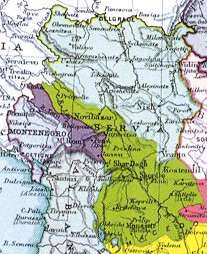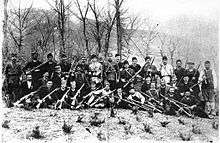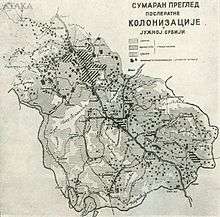Serbianisation
Serbianisation or Serbianization, also known as Serbification[1], and Serbisation or Serbization (Serbian: србизација/srbizacija or посрбљавање/posrbljavanje; Bulgarian: сърбизация, sərbizacija or посръбчване, posrəbčvane; Romanian: serbificarea) is the spread of Serbian culture, people, or politics, either by integration or assimilation.
In Vardar Macedonia

The region of present-day Republic of Macedonia until 1912 was part of the Ottoman Empire. According to Encyclopædia Britannica 1911 Edition, at the beginning of the 20th century the Slavs constituted the majority of the population in Macedonia. Per Britannica itself the bulk of the Slavs there was regarded by almost all independent sources as "Bulgarians". Immediately after annexation of Vardar Macedonia to the Kingdom of Serbia, the Macedonian Slavs were faced with the policy of forced serbianisation.[2][3]
We find here, as everywhere else, the ordinary measures of "Serbization" — the closing of schools, disarmament, invitations to schoolmasters to become Servian officials, nomination of "Serbomans", "Grecomans" and Vlachs, as village headmen, orders to the clergy of obedience to the Servian Archbishop, acts of violence against influential individuals, prohibition of transit, multiplication of requisitions, forged signatures to declarations and patriotic telegrams, the organization of special bands, military executions in the villages and so forth.[4]

Those who declare as the Bulgarians were, harassed or deported to Bulgaria.[5] The high clergymen of Bulgarian Orthodox Church were also deported.[6] Bulgarian schools were closed and teachers expelled. The population of Macedonia was forced to declare as Serbs. Those who refused were beaten and tortured.[7] Prominent people and teachers from Skopje who refused to declare as Serbs were deported to Bulgaria.[6] International Commission concluded that the Serbian state started in Macedonia wide sociological experiment of "assimilation through terror."[6]

During the Kingdom of Serbs, Croats and Slovenes, the government of the Kingdom pursued a linguistic Serbisation policy towards population of the Macedonia,[8] then called "Southern Serbia" (unofficially) or "Vardar Banovina" (officially). The dialects spoken in this region were referred to as dialects of Serbo-Croatian.[9] Either way, those southern dialects were suppressed with regards education, military and other national activities, and their usage was punishable.[10]
The Kingdom, was also interested to change the ethnic composition of the population in Vardar Macedonia. In 1919 there were announced the orders for preparing for colonization of Southern Serbia. The Serbian colonization was maintained through "agricultural" and "administrative" actions. In the Interbellum, the Kingdom has settled 3,670 families (18,384 persons). The colonists were given properties. Also, in the same time almost all clerks in the area were Serbs. This means that in the period between the two World wars the Kingdom succeeded through the agricultural and the administrative colonizations to create significant Serbian ethnic minority in Vardar Macedonia.[11] As a counteraction the paramilitary IMRO began sending armed bands into Yugoslav Macedonia to assassinate officials and stir up the spirit of the locals. After 1923 the IMRO had de facto full control of Bulgarian Macedonia and acted as a "state within a state". It used Bulgaria as a base for terrorist attacks against Yugoslavia with the unofficial agreement of the right-wing governments. Because of this, contemporary observers described the Yugoslav-Bulgarian border as the most fortified in Europe. In 1930s a more homogeneous generation was growing up in Vardar Macedonia, which resisted Serbianisation and increasingly identified itself as Macedonian, but which also made it clear that Bulgarian idea was no more the only option for them.
After WWII Marshal Tito formed out SR Macedonia of a part of 1929–1941 Vardar Banovina, and encouraged the development of Macedonian identity and Macedonian as a separate South Slavic language.[12] The Macedonian national feelings were already ripe, but some researchers argue that even then, it was questionable whether the Macedonian Slavs considered themselves to be a nationality separate from the Bulgarians.[13] However persons declaring Bulgarian identity were again imprisoned or went into exile, and in this way Vardar Macedonia was finally de-Bulgarised.[14]

Today some researchers have described the process of codifying the Macedonian language during 1945 - 1950 as 'Serbianization'. Within the period of Macedonian language codification two tendencies emerged: one language majority, that was pro-Macedonian, with some pro-Bulgarian biases, and one language minority openly pro-Serbian. The language minority, with the help of the Yugoslav political establishment defeated the language majority.[15] The irreversible turning point of Serbianisation of the Macedonian standard took place in the late 1950s.[16] On the other hand during the time of federation in Socialist Yugoslavia, Yugoslav citizens learned Serbo-Croatian at school. This bilingualism was stimulated by the subordinated pro-Serbian elites in Yugoslav Macedonia.[17][18] In this way the influence of Serbo-Croatian arrose so much, that the colloquial speech of the capital Skopje has been described as a "creolized form of Serbian".[18]
After Republic of Macedonia gained independence in 1991 this process still continues. In 2015 the former prime minister and leader of the VMRO-NP, Ljubco Georgievski has claimed in an interview to Radio Free Europe that then Macedonian authorities have a clear goal, to keep the country closer to Serbia, and at some future stage to join the northern neighbor. According to him a classical pro-Yugoslav policy has being conducted, where confrontation with all the other neighbors was taking place, but the border between Macedonian and Serbian national identity has been erased.[19] "Stop the Serbian assimilation of the Macedonian nation" was the motto of the billboards that were placed then on Skopje streets, through which the Party launched a campaign for preserving the Macedonian national identity.
Romanians and Vlachs
Voluntarily Serbianisation has been attributed to Romanians and Vlachs, since the 19th century.[20]
Hungarians
The Hungarian minority in north Serbia (Vojvodina) has also been affected by Serbianisation since the aftermath of World War II.[21]
De-Serbianisation
Croatia
In the Military Frontier (1500–1800)
Serbs in the Roman Catholic Croatian Military Frontier were out of the jurisdiction of the Serbian Patriarchate of Peć and in 1611, after demands from the community, the Pope establishes the Eparchy of Marča (Vratanija) with seat at the Serbian-built Marča Monastery and instates a Byzantine Rite vicar bishop as sub-ordinate to the Roman Catholic bishop of Zagreb, working to bring Serbian Orthodox Christians into communion with Rome which caused struggle of power between the Catholics and the Serbs over the region. In 1695 Serbian Orthodox Eparchy of Lika-Krbava and Zrinopolje is established by metropolitan Atanasije Ljubojevic and certified by Emperor Josef I in 1707. In 1735 the Serbian Orthodox protested in the Marča Monastery and it became a part of the Serbian Orthodox Church until 1753 when the Pope restored the Roman Catholic clergy at it. On June 17, 1777 the Eparchy of Križevci is permanently established by Pope Pius VI with see at Križevci, near Zagreb, thus forming the Croatian Greek Catholic Church which would after the World War I include other people; Rusyns and Ukrainians of Yugoslavia.[22][23]
Kosovo
The term Arnauti or Arnautaši was coined by Serbian ethnographers for allegedly "Albanized Serbs"; Serbs who were thought to have converted to Islam and supposedly went through a process of Albanisation.[24][25]
In Orahovac
At the end of the 19th century, writer Branislav Nušić recorded that the Serb poturice (converts to Islam) of Orahovac began speaking in Albanian and marrying Albanian women.[25]
When Dr Jovan Hadži Vasiljević (l. 1866–1948) visited Orahovac in World War I, he could not distinguish Orthodox from Islamicized and Albanized Serbs.[25] They spoke Serbian, wore the same costumes, but claimed Serbian, Albanian or Turk ethnicity.[25] The Albanian starosedeoci (old urban families) were Slavophone; they did not speak Albanian but a Slavic dialect (naš govor, Our language) at home.[25]
In the 1921 census the majority of Muslim Albanians of Orahovac were registered under the category "Serbs and Croats".[25] This is contrary to the belief that Islamisation led to Albanisation. This suggests that claims of Islamisation has led to Albanisation of Serbs are difficult to prove. Also, there has been a continuous and considerable presence of a Slavic Muslim population in Kosovo.
Mark Krasniqi, the Kosovo Albanian ethnographer, recalled in 1957:[25] "During my own research, some of them told me that their tongue is similar to Macedonian rather than Serbian (it is clear that they want to dissociate themselves from everything Serbian[25]). It is likely they are the last remnants of what is now known in Serbian sources as 'Arnautaši', Islamicised and half-way Albanianised Slavs."[25]
Notable individuals of non-Serb origin who declare as Serbs
- Đorđe Vajfert, industrialist and Governor of the National Bank of Serbia and later Yugoslavia, of German origin.
- General Pavle Jurišić Šturm (Paulus Sturm), World War I hero, born in Prussia, of Sorbian ethnicity.
- Branislav Nušić, writer, Aromanian father from Macedonia.
- Peter Ichko, diplomat, of Aromanian origin.
See also
Notes
- ↑ "The Real Face of Serbian Education in Macedonia". newspaper "Makedonsko Delo", No. 9 (Jan. 10, 1926), Vienna, original in Bulgarian. Retrieved 2007-08-03.
- ↑ Dejan Djokić, Yugoslavism: histories of a failed idea, 1918–1992, p. 123, at Google Books
- ↑ R. J. Crampton, Eastern Europe in the twentieth century—and after, p. 20, at Google Books
- ↑ "Report of the International Commission to Inquire into the Causes and Conduct of the Balkan War". archive.org. Retrieved 2015-04-12.
- ↑ Report of the International Commission to Inquire into the Causes and Conduct of the Balkan Wars (p. 52)
- 1 2 3 Report of the International Commission to Inquire into the Causes and Conduct of the Balkan Wars (p. 165)
- ↑ Report of the International Commission to Inquire into the Causes and Conduct of the Balkan Wars (p. 53)
- ↑ "An article by Dimiter Vlahov about the persecution of the Bulgarian population in Macedonia". newspaper "Balkanska federatsia", No. 140, 20 August 1930, Vienna, original in Bulgarian. Retrieved 2007-08-03.
- ↑ Friedman, V. (1985). "The Sociolinguistics of Literary Macedonian". International Journal of the Sociology of Language. 52: 31–57. doi:10.1515/ijsl.1985.52.31.
- ↑ "By the Shar Mountain there is also terror and violence". newspaper "Makedonsko Delo", No. 58, 25 January 1928, Vienna, original in Bulgarian. Retrieved 2007-08-03.
- ↑ Стојан Киселиновски, Етничките промени во Македонија: 1913-1995, Институт, 2000, ISBN 9989624518.
- ↑ War of words: Washington tackles the Yugoslav conflict, p. 43, at Google Books
- ↑ The Macedonian conflict: ethnic nationalism in a transnational world, Loring M. Danforth, Princeton University Press, 1997, ISBN 0-691-04356-6, pp. 65-66.
- ↑ Europe Since 1945: An Encyclopedia by Bernard Anthony Cook ISBN 0-8153-4058-3
- ↑ Stojan Kiselinovski, Historical Roots of the Macedonian Language Codification, Polish Academy of Sciences, 2016, Studia Srodkowoeuropejskie i Bałkanistyczne, pp. 133-146. DOI: 10.4467/2543733XSSB.16.009.6251
- ↑ Voss C., The Macedonian Standard Language: Tito—Yugoslav Experiment or Symbol of ‘Great Macedonian’ Ethnic Inclusion? in C. Mar-Molinero, P. Stevenson as ed. Language Ideologies, Policies and Practices: Language and the Future of Europe, Springer, 2016, ISBN 0230523889, p. 126.
- ↑ Language ideologies, policies and practices by Clare Mar-Molinero, Patrick Stevenson (Editor) - The Macedonian standard language: Tito-Yugoslav experiment or symbol for “Great Macedonian” ethnic inclusion? Christian Voss, ISBN 9780230580084, Palgrave Macmillan, 2009, pp. 120-122.
- 1 2 The languages and linguistics of Europe: A comprehensive guide, Hans Henrich, Bernd Kortmann, Johan van der Auwera, Walter de Gruyter, 2011, ISBN 3110220261, p. 420.
- ↑ Радио Слободна Европа, јануари 23, 2015, Марија Митевска, Србизација на Македонија?
- ↑ M. V. Fifor. Assimilation or Acculturalisation: Creating Identities in the New Europe. The case of Vlachs in Serbia. Published in Cultural Identity and Ethnicity in Central Europe, Jagellonian University, Cracow
- ↑ Frederick Bernard Singleton, Twentieth-century Yugoslavia, New York, Columbia University Press, 1976, p. 222
- ↑ Encyclopedia of Rusyn History and Culture at Google Books
- ↑ Geopolitics of European Union Enlargement: The Fortress Empire at Google Books
- ↑ Dietmar Müller, Staatsbürger aus Widerruf: Juden und Muslime als Alteritätspartner im rumänischen und serbischen Nationscode: ethnonationale Staatsbürgerschaftskonzepte 1878–1941, p. 183–208. ISBN 3-447-05248-1, ISBN 978-3-447-05248-1
- 1 2 3 4 5 6 7 8 9 Religion and the politics of identity in Kosovo, p. 73: see footnotes